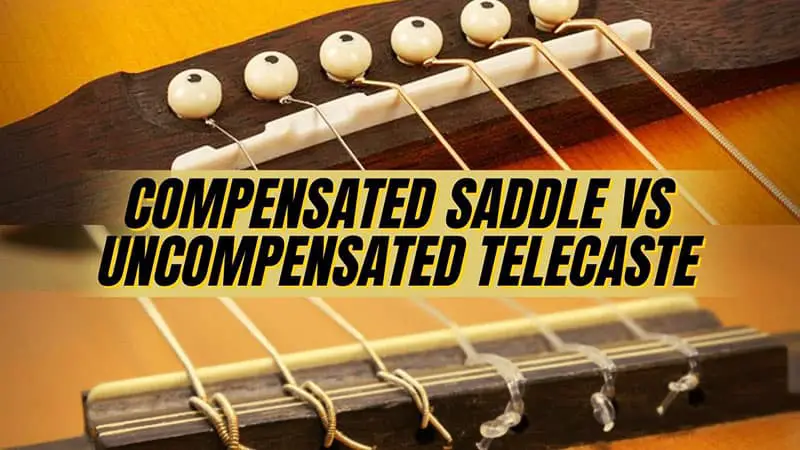Having a Fender Telecaster is almost like a dream come true for a guitar lover. But the compensated and uncompensated (non-compensated) saddle might make a significant difference according to the type of guitar player you are.
Compensated saddle in a telecaster is better than the uncompensated saddle, in general. This is because, the compensated saddles provide more options for a guitar player- especially for lead guitarists than the non-compensated saddle.
Let’s see what is the fuss about compensated and non-compensated or uncompensated r straight saddle, however you like to call it. Apart from their structural differences, there is a whole lot more you’d find interesting about them and they’d help you become a better guitarist as well as guitar-tech.
Compensated vs Uncompensated Telecaster Saddle
It’s pretty obvious that you’d know saddles. However, in case you are referring this writing to a friend who is totally new to guitar stuffs, let’s break it down a bit and start with “what is a saddle?” I promise I won’t bore you too much with the basics.
A guitar saddle is upon which the guitar strings rest. And this part is found on the bridge of the guitar. It is usually white and made of bones(natural) or synthetic plastics. Well, this is the case for an acoustic guitar.
For an electric guitar, saddles are the are of numerous types and are usually made of metal alloys. Since we are talking about Telecasters, let’s keep our discussion limited to what types of saddles do these magnificent pieces of guitars have.
Compensation, in short, is known as the adjustment of the string length of an acoustic or electric guitar, which is generally referred to as scale length. For proper pitch, intonation, and string action, compensation is often required.
Fender Telecaster Saddles
If you don’t know it already, among the Telecasters, Fender Vintage American is the hot favorite. And I’m pretty sure you’ve seen this guitar plenty of times. The vintage style tele had three barrel-shaped saddles which we will refer to as uncompensated or non-compensated ones.
Then comes the compensated saddle, which are barrel-shaped saddles with grooves on them. The most modern Telecasters have a six-saddle bridge system, about which we’ll talk later in this article.
Compensated Tele Saddle
Like I mentioned, compensated saddles have an uneven surface where the electric guitar strings sit. There are slight grooves or trenches or slightly flattened for particular strings. For a tele style saddles, those particular strings are A, D, and High E strings.
Pros
- This design helps the strings to get their intonation conveniently.
- Great for the lead guitarists who plays solo on higher frets such as above 7th fret or 10th
- The saddle alignment is neat, therefore looks good.
Cons
- The setting is a bit tricky.
- Cost’s a bit higher than the regular barrel-shaped saddles.
Uncompensated Saddle
All the Fender American vintage Tele has the three barrel-shaped smooth-surfaced bridge saddle. Here, it doesn’t matter which strings you place on whichever saddle, because all the saddles are of the same size and shape.
Pros
- Setting up is super easy.
- Classy Vintage Look.
- Costs less than compensated saddles.
Cons
- Difficult and tricky to achieve the accurate intonation of the strings
- The alignment of the saddles is in a wave shape, which looks a bit odd.
What is String Intonation?
You’ve heard of strings intonation, right? Nevertheless, let’s go through that one more time. Simply put, the string’s intonation is done simply by adjusting the string’s scale length (length between the saddle and the nut).
When accurate intonation is achieved, the guitar remains in tune and the notes played whether in higher frets or lower frets have the proper sustenance. The reverberance is also improved whether playing rhythm or lead.
Without the proper intonation, your guitar strings will be an inconvenience to place your fingers on. The tone would not hold as long as you expect it to. And sometimes there would be fret buzz if the strings are
Does the Saddle Type Affect Guitar Tone?
Saddle types do affect the guitar tone, but not that significantly. On the other hand, saddle materials can modify the guitar tone to a certain extent.
Along with the saddle materials, the bridge material of the tele decides the tone altogether. The bridge material and the saddle materials are usually similar when they are made. So, you’ll find a slight tonal difference if you install compensated saddled of a different material.
Types of Telecaster Saddle Materials
The most common materials for telecaster saddles are brass and steel. Modern manufacturers have introduced alloys such as aluminum, chrome-plated brass, graphite, etc.
By far, the most popular one is the brass saddles. It looks vintages, sounds vintage as well.
Steel saddles also bring out the vintage tone pretty well, but the brass saddles make a fuller and deeper sound.
Graphite and aluminum both sound good enough, have a modern feel in them. Ironically, that is the reason for many vintage lovers to avoid these saddles.
How to Install Compensated Saddles in a Telecaster
If your Fender Vintage American Telecaster or any vintage tele models have built-in 3-Brass non-compensated saddles, and you wish to install one, you can probably do it at home with some adequate instructions.
Compensated tele saddles are available, and you’d have to choose the material of your preference. Since these are three saddles, each supporting two of the guitar strings, it is fairly easy to unscrew the old ones and install the new saddles.
Just make sure to arrange the saddles in such a way that, the grooves of the compensated saddle fall in the places of A(5th string), D (4th String), and High E string (1st string). You can take help from YouTube if necessary.
Don’t forget to align the guitar strings properly to attain the best intonation. This part is quite tricky if you are totally new to it. So, experienced guitar tech or a friend can help you out. And there is always, YouTube.
Modern Six-Saddle Telecaster
The Vintage Fender Telecaster models usually have the three-bridge, each saddle supports two strings as I mentioned. For this reason, achieving the perfect intonation is quite difficult in most cases, even with the compensation.
To alleviate this issue, Fender guitar makers have introduced modern telecaster models with an upgraded six-saddle bridge. As the name suggests, there is one saddle for each of the guitar strings. This allows a guitar player to perfectly intonate individual strings without disturbing another, unlike the vintage saddles.
This type of saddle gives a modern look, sounds modern as well. So, if you are not a retro lover, you can consider this as an option. I played this type of tele several times and I loved it.
Acoustic Saddles in a Nutshell
Acoustic guitar saddles have trenches or grooves for B string (2nd string) usually; some even have multiple grooves to compensate several strings. There is a saddle slot in an acoustic guitar’s bridge to accommodate the saddle.
They usually have compensated or non-compensated bone saddles. But recently, man-made saddles composed of synthetic material are getting popular. Although, some people feel the tone of the bone saddled guitar is better than the synthetic ones.
Not all the acoustic guitar requires compensated saddle. Nylon string guitars such as classical guitars have straight saddles. The nylon strings don’t differ in density that much, unlike the steel strings. So, finetuning the string’s action is not essential in that case.
FAQs
Is it a Must to Have Compensated Saddles in my Telecaster?
It depends on the type of guitarist you are. Most of the rhythm guitar players or riff guitarists don’t bother about it that much because they mostly remain below the 5th fret of the guitar.
Also, occasion guitar players won’t need to worry about it that much, because, they’d hardly notice the difference/inconvenience of not having compensated saddles.
However, for a regular and passionate guitarist, it is sort of a must-have. Eventually, you’ll know how important it is once you delve so deep into playing the guitar. If you are playing a telecaster, play it in its best form!!
Changing the Saddle: is it Worth the Time and Money?
Again, if you are a serious guitar player and want to perform/record in studios, yes. This is totally worth it. For long-term and heavy usage, the guitar needs to be in its best form. Having a compensated bridge would save you a lot of time from string tuning and alignment.
Final Words
Fender Telecaster is already a magnificent guitar, and it sounds heavenly. Only the saddles won’t make much of a difference in their performance. But for your own convenience and preference, you can choose what suits you best; I’m pretty sure you have the knowledge of a beginner guitar-tech now.


